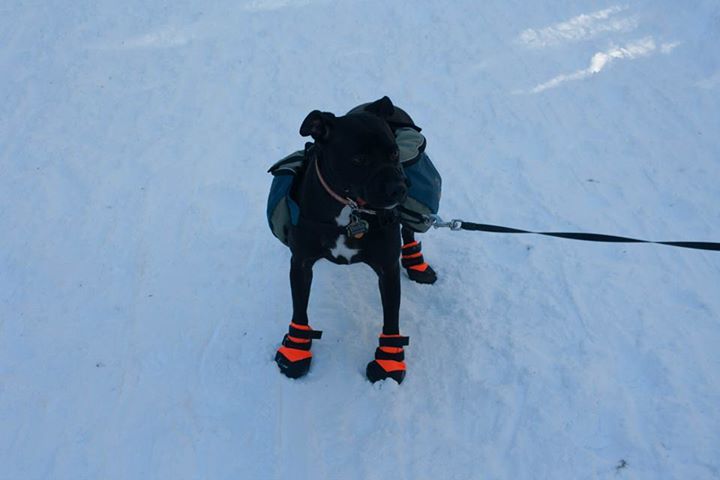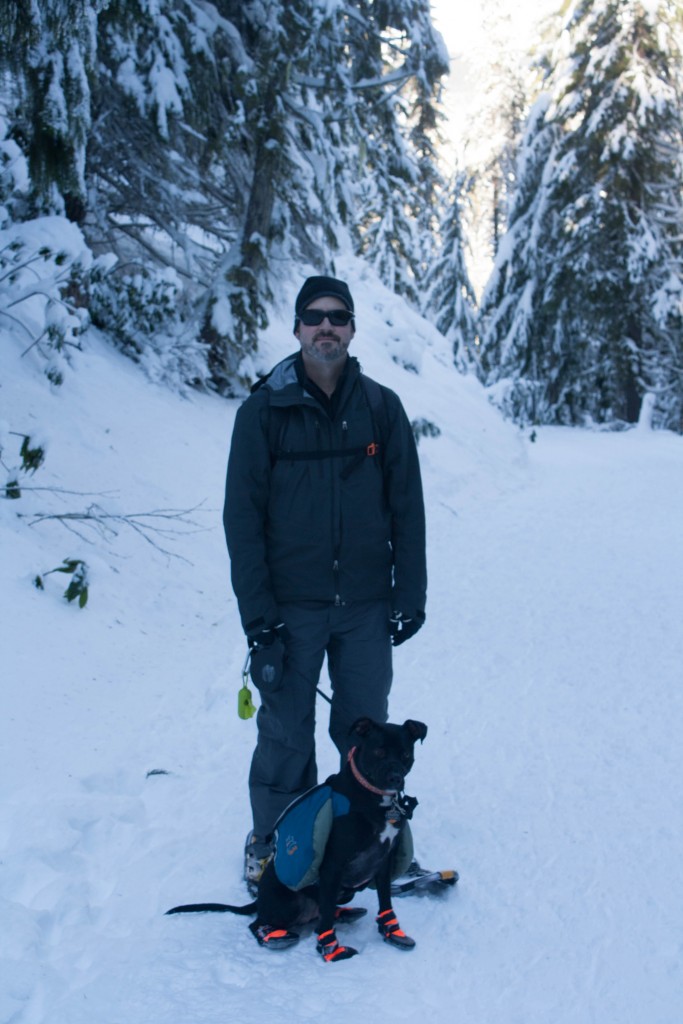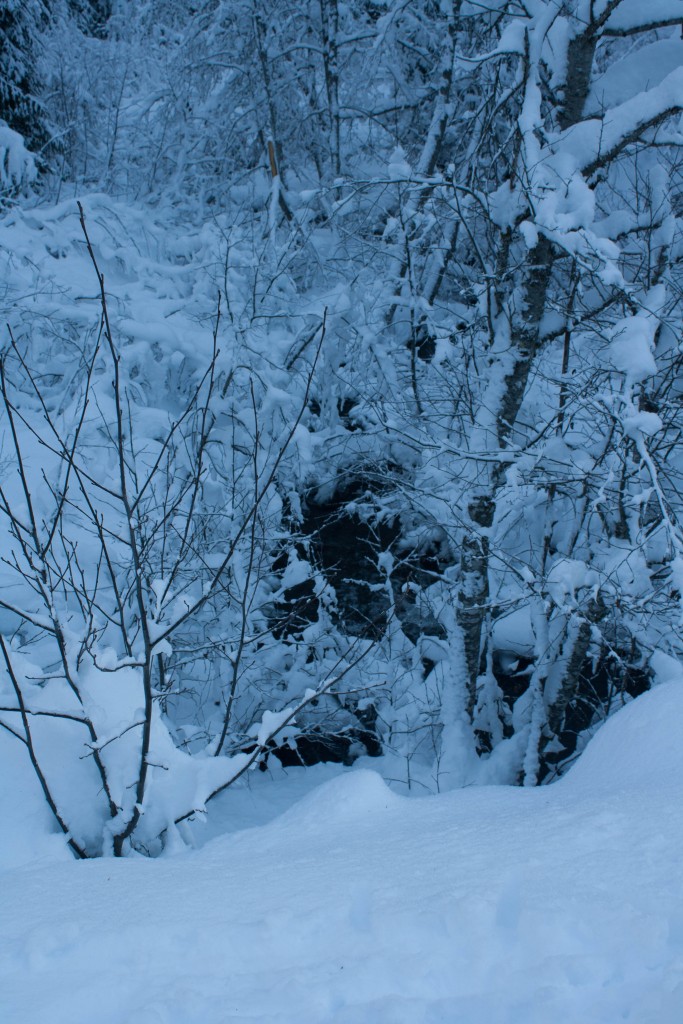When we go snowshoeing we have the usuals we pack with us: compass, first aid kit, emergency kit (including matches, hand-warmers, emergency blankets), flashlight, snacks, extra gloves/hats etc. Read this post I wrote about snowshoeing safely: Snowshoeing Safety Tips.
Now that we have Bella we bring extra stuff for her. She has a little pack that she wears when we hike that carries her “gear.” It’s not heavy and she doesn’t mind the pack. In her pack are poo bags, her collapsible water dish, her booties, and extra snacks.
We recently went snowshoeing and decided to leave Bella at home. While we had the gear and stuff for her, it was just a better idea. Sure it would be nice to have her with us whenever we go out and play in the snow, but sometimes the temperature is just too severe (and 15 degrees was definitely too cold for her!). The thing is, it makes a difference what kind of dog you have. You got a big fluffy husky or a dog with lots of hair? They would probably be okay in snow and low temperatures like that. But our Miss Bella has very short hair and a bare belly so not a good plan for her. So after you make the decision on temperatures and your own dog, go ahead and read some of these tips:
Check for signs of hypothermia.
This was something I didn’t know a lot about before we got a dog. When we take her hiking, I keep an eye on her for changes in behavior due to weather. When we hike in the summer we make sure she gets a ton of water and plenty of rest in the shade when it’s hot. There have been times when she was panting a LOT and I was concerned she was overheating. We’re still figuring things out. Hypothermia is scary because it can happen so fast.
“Puppies and elderly dogs are especially susceptible; watch for shivering, slowed breathing or dilated pupils, signs of a dangerous drop in body temperature. We pack plenty of snacks and water, and examine our Labs’ paws frequently for the ice and snow that can clump between pads. (source)”
Check the paws frequently.
Snow and ice can get stuck between the pads and chafe, cut, freeze or cause loss of traction. Bella has a history of paw injuries so we are super diligent about checking her paws on a regular basis and taking steps to make sure they are protected. Some of the things I’ve used are the following products:
Musher’s Secret – It’s similar to vaseline in consistency. We tried this for a little bit snowshoeing but I realized it came off too easily and we switched to her booties (which was a good decision).
Eqyss Mega Tek Coat Rebuilder — This is what I use on Bella’s paws when they are starting to feel rough. I used this after our snowshoeing trip and after every hike for a few days afterward to protect and build her paws back up.
Ultra Paws Rugged Dog Boot — These boots are AMAZING. They have helped Bella so much with her paw issues! I would never snowshoe without these. They are a must.
It’s a good idea to stick to trails that are compacted and not super deep. Having booties will do nothing if the dog sinks down into deep snow.
Bring plenty of snacks for the dog.
Bella got some treats for Christmas so I packed them along with us and we stopped a lot for treats. I knew she’d be burning a lot of calories and energy playing in the snow and I wanted to make sure she was okay. It’s a good idea to pack a “survival” kit for your dog when going hiking or snowshoeing.
Bring enough water for you AND the dog.
Get a collapsible water bowl. It’s great! It’s easy to pack in her pack, or ours, and we stop a lot for her to have water breaks. She’s pretty intuitive and knows when she needs water and when she’s done drinking. So make sure to pack enough water for you AND your dog. And stop frequently for water and snack breaks.
Bring a small, waterproof blanket/towel for the dog to sit/rest on.
This is something I didn’t even think about until I read some articles online. It makes sense. When stopping for a break, it’s a good idea to have one so the dog doesn’t have to sit in the snow and they get a break that isn’t freezing cold. DUH. I’d tell her to sit and she looked so miserable. I get it Bella, sorry!! Parent fail.
Stay on trail.
This is something I just do anyways. Dog or no, I am not into back-country snowshoeing or hiking off trail. It’s just not a good idea. Unless you are a seasoned hiker with maps and GPS and survival skills, it’s a bad idea and you’ll most likely end up on the news. 😛 So be smart, stay on the trail and keep your dog safe by doing this too!
In the same vein….Keep dog on the leash. You never know what dangers are out there. Other animals, wild animals, cliffs, lakes partially iced over, snow banks, TREE WELLS!!–a million dangers are out there. It’s just wise to keep the dog on the leash at all times while hiking/snowshoeing.
What are some of your go-to tips you have regarding hiking/snowshoeing with your dogs?




Ingunn
Snowshoeing with dogs – here’s one area where I and my furless wonder don’t have much experience! 😉 But I chuckled at “stay on trail” – up here there’s no such thing as a trail when you snowshoe! Plus, in some cases, if you do try to follow a summer trail, it could take you into sketchy avalanche-prone territory.
Lisa Eirene
There are a handful of good snowshoeing trails here on Mount Hood (and even more in Bend but a lot of them for some reason say no dogs–which seems weird to me). The trails are marked well and easy to follow. Some are groomed (like Trillium Lake) so you can’t really get off trail and get lost or get stuck in really deep snow. But there are also a bunch of trails that I probably wouldn’t snowshoe on because I am definitely not a back-country explorer. It’s not for me! I don’t have the navigation skills to try it and like you said, it can be sketchy and avalanche prone.
Ingunn
That’s cool! The only marked trails that I know of up here are for xc skiing. There’s a Snowshoeing Washington (or something like that) book that has suggested routes though.
Lisa Eirene
I’ve never been snowshoeing in Washington. Someday I hope!
Fran
It’s never that cold here but you have some good tips.
When we have snow here, I always make sure her paws are dry and clean when we get back home. Since they use salt here for icy roads, it’s important to take care of her paws. I often use vaseline after I got home.
That blanket idea is a good one, I’ll remember that one if it ever gets cold here and we go on a hike.
You might consider buying her a jacket to stay warm at those temperatures.
Hopefully the cold will go away soon but you will still have some snow so Bella can play in it. Bet she loves it as much as my Bella.
Lisa Eirene
Good point on the salt. Here in Oregon they don’t use salt on the icy roads but they use gravel (which is really gross after the snow and ice goes away). I hope your Bella’s paws are ok. I know whenever Bella’s gets bad it’s about a week or two to heal them.
We bought Bella a fleece lined waterproof “cape” thing. It’s not quite a jacket because her belly is bare but it’s warm and covers most of her body. I should probably look into some kind of sweater-type thing someday.
Fran
So far we haven’t had any snow and we have had no icy roads. So for now her paws are okay.
Lisa Eirene
That’s good. I always feel so bad when our fur babies are injured! 🙁